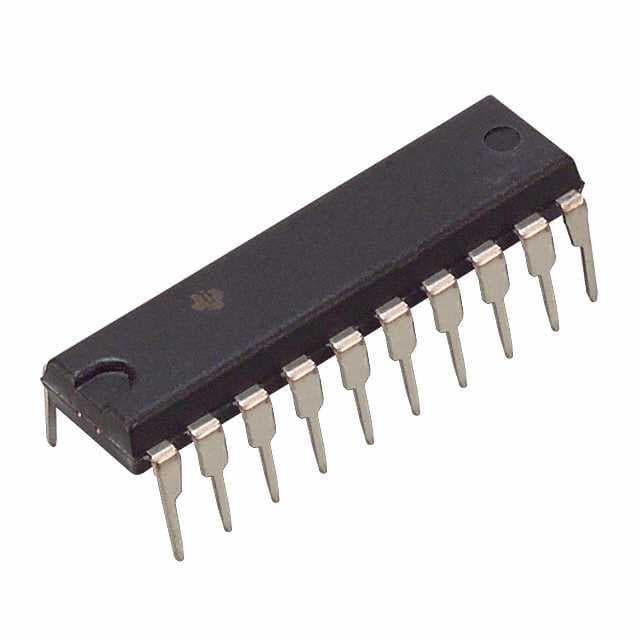Viz Specifikace pro podrobnosti o produktu.

SN64BCT245N
Product Overview
Category
SN64BCT245N belongs to the category of integrated circuits (ICs).
Use
This IC is commonly used for level shifting and signal buffering in digital systems.
Characteristics
- High-speed operation
- Wide voltage range compatibility
- Bidirectional data transfer capability
- Non-inverting logic levels
- 3-state outputs
Package
SN64BCT245N is available in a standard 20-pin DIP (Dual Inline Package) or SOIC (Small Outline Integrated Circuit) package.
Essence
The essence of SN64BCT245N lies in its ability to provide seamless and efficient communication between devices operating at different voltage levels.
Packaging/Quantity
SN64BCT245N is typically packaged in tubes or reels, with quantities varying based on customer requirements.
Specifications
- Supply Voltage: 4.5V to 5.5V
- Input Voltage Range: 0V to VCC
- Output Voltage Range: 0V to VCC
- Operating Temperature Range: -40°C to +85°C
- Maximum Propagation Delay: 10ns
- Maximum Output Current: ±24mA
Detailed Pin Configuration
- OE (Output Enable)
- A1 (Input/Output)
- B1 (Input/Output)
- GND (Ground)
- B2 (Input/Output)
- A2 (Input/Output)
- VCC (Supply Voltage)
- DIR (Direction Control)
- B3 (Input/Output)
- A3 (Input/Output)
- B4 (Input/Output)
- A4 (Input/Output)
- B5 (Input/Output)
- A5 (Input/Output)
- B6 (Input/Output)
- A6 (Input/Output)
- B7 (Input/Output)
- A7 (Input/Output)
- B8 (Input/Output)
- A8 (Input/Output)
Functional Features
- Bidirectional data transfer: Allows data to be transmitted in both directions.
- Non-inverting logic levels: Ensures that the output signal matches the input signal.
- 3-state outputs: Enables multiple devices to share a common bus without interference.
Advantages and Disadvantages
Advantages
- High-speed operation facilitates efficient data transfer.
- Wide voltage range compatibility allows for versatile usage.
- Bidirectional capability simplifies system design.
- Non-inverting logic levels ensure accurate signal transmission.
- 3-state outputs enable bus sharing among multiple devices.
Disadvantages
- Limited number of input/output pins restricts the number of devices that can be connected simultaneously.
- Not suitable for applications requiring higher current handling capabilities.
Working Principles
SN64BCT245N operates by receiving input signals from one device, level shifting them if necessary, and transmitting the signals to another device operating at a different voltage level. The direction of data flow is controlled by the DIR pin. When enabled, the IC allows bidirectional data transfer between the devices.
Detailed Application Field Plans
SN64BCT245N finds applications in various digital systems where level shifting and signal buffering are required. Some common application fields include:
- Microcontroller interfacing with external peripherals.
- Communication interfaces between devices operating at different voltage levels.
- Data buses in computer systems and embedded systems.
- Industrial automation systems.
- Robotics and control systems.
Detailed and Complete Alternative Models
- SN74LVC245A: Similar functionality with lower power consumption.
- MC74LVX245: Higher voltage tolerance with comparable performance.
- CD74HCT245: Higher current handling capability for demanding applications.
- 74HC245: Lower cost alternative with slightly reduced performance.
(Note: The above list is not exhaustive and other alternative models may exist in the market.)
In conclusion, SN64BCT245N is a versatile integrated circuit used for level shifting and signal buffering in digital systems. Its high-speed operation, wide voltage range compatibility, and bidirectional data transfer capability make it suitable for various applications. While it has limitations in terms of pin count and current handling, there are alternative models available to suit specific requirements.
Seznam 10 běžných otázek a odpovědí souvisejících s aplikací SN64BCT245N v technických řešeních
Sure! Here are 10 common questions and answers related to the application of SN64BCT245N in technical solutions:
Q: What is SN64BCT245N? A: SN64BCT245N is a non-inverting octal bus transceiver with 3-state outputs, commonly used for bidirectional data transfer between different voltage levels.
Q: What is the operating voltage range of SN64BCT245N? A: The operating voltage range of SN64BCT245N is typically from 4.5V to 5.5V.
Q: Can SN64BCT245N be used for level shifting between different voltage domains? A: Yes, SN64BCT245N can be used for level shifting between voltage domains as it supports bidirectional data transfer.
Q: How many channels does SN64BCT245N have? A: SN64BCT245N has 8 bidirectional channels, allowing for simultaneous data transfer on multiple lines.
Q: What is the maximum data transfer rate supported by SN64BCT245N? A: SN64BCT245N supports high-speed data transfer up to 80 MHz.
Q: Can SN64BCT245N handle both TTL and CMOS logic levels? A: Yes, SN64BCT245N is compatible with both TTL and CMOS logic levels, making it versatile for various applications.
Q: Does SN64BCT245N have built-in protection features? A: Yes, SN64BCT245N has built-in ESD protection diodes to safeguard against electrostatic discharge events.
Q: Can SN64BCT245N be used in bi-directional communication systems? A: Yes, SN64BCT245N is designed for bidirectional data transfer, making it suitable for bi-directional communication systems.
Q: What is the power supply current consumption of SN64BCT245N? A: The power supply current consumption of SN64BCT245N is typically around 10 mA.
Q: Can SN64BCT245N be used in automotive applications? A: Yes, SN64BCT245N is qualified for automotive applications and can withstand harsh operating conditions.
Please note that these answers are general and may vary depending on specific datasheet specifications and application requirements.

